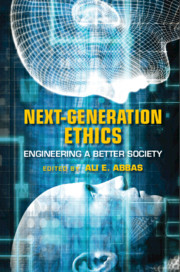Book contents
- Next-Generation Ethics
- Next-Generation Ethics
- Copyright page
- Contents
- Contributors
- Acknowledgment
- 1 Next-Generation Ethics
- 2 Ethical Distinctions for Building Your Ethical Code
- Part I Technology
- Part II Business Enterprises
- Part III Engineering
- 15 A Whistle Not Blown: VW, Diesels, and Engineers
- 16 Addressing Corruption in Our Global Engineering/Construction Industry
- 17 Ethical Issues Facing Engineers in Oil and Gas Operations
- 18 Engineering Codes of Ethics: Legal Protection and Empowerment for Engineers
- 19 Engineering Ethics When Lives Are on the Line: When Does Bad Engineering Become Bad Ethics?
- 20 Case Studies of Product Life Cycle Environmental Impacts for Teaching Engineering Ethics
- Part IV Society
- Index
- References
19 - Engineering Ethics When Lives Are on the Line: When Does Bad Engineering Become Bad Ethics?
from Part III - Engineering
Published online by Cambridge University Press: 18 October 2019
- Next-Generation Ethics
- Next-Generation Ethics
- Copyright page
- Contents
- Contributors
- Acknowledgment
- 1 Next-Generation Ethics
- 2 Ethical Distinctions for Building Your Ethical Code
- Part I Technology
- Part II Business Enterprises
- Part III Engineering
- 15 A Whistle Not Blown: VW, Diesels, and Engineers
- 16 Addressing Corruption in Our Global Engineering/Construction Industry
- 17 Ethical Issues Facing Engineers in Oil and Gas Operations
- 18 Engineering Codes of Ethics: Legal Protection and Empowerment for Engineers
- 19 Engineering Ethics When Lives Are on the Line: When Does Bad Engineering Become Bad Ethics?
- 20 Case Studies of Product Life Cycle Environmental Impacts for Teaching Engineering Ethics
- Part IV Society
- Index
- References
Summary
Numerous engineering projects create products and services that are important to society; many have explicit safety implications; some are distinguished by explicitly supporting national security. Failures and deficiencies that might be considered “routine” in some settings can in these cases directly cause injuries and lost lives, in addition to harming national security. In such a setting, decisions regarding quality, testing, reliability, and other “engineering” matters can become ethical decisions, where balancing cost and delivery schedule, for example, against marginal risks and qualities is not a sufficient basis for a decision. When operating in the context of an engineering project with such important societal implications, established engineering processes must therefore be supplemented with additional considerations and decision factors. In this chapter, long-time defense contractor executive and US National Academy of Engineering member Neil Siegel discusses specific examples of ways in which these ethical considerations manifest themselves. The chapter starts with his thesis, asserting that bad engineering risks transitioning into bad ethics under certain circumstances, which are described in the chapter. It then uses a story from the NASA manned space program to illustrate the thesis; unlike some stories, this one has a “happy ending.” The author then moves to the main aspects of the chapter, starting by explaining the behavioral, evolutional, and situational factors that can tempt engineers into unethical behavior: how do engineers get into situations of ethical lapse? No one enters a career in engineering intended to put lives and missions at risk through ethical lapses; at the very least, this is not the path to promotion and positive career recognition. With the basis for such behavior established, the author then defines what he calls the characteristics of modern systems that create risk of ethical lapse; he identifies five specific traits of modern societal systems – systems of the sort that today’s engineers are likely to be engaged in building – as being those that can allow people to slip from bad engineering into bad ethics. These characteristics are then illustrated with examples, from everyday engineering situations, such as working to ensure the reliability of the electric power grid, and designing today’s automobiles. The very complexities and richness of features that distinguish many of today’s products and critical societal systems are shown to become a channel through which bad engineering can transition into bad ethics. Lastly, the chapter discusses some of the author’s ideas about how to correct these situations, and guard against these temptations.
- Type
- Chapter
- Information
- Next-Generation EthicsEngineering a Better Society, pp. 271 - 290Publisher: Cambridge University PressPrint publication year: 2019

